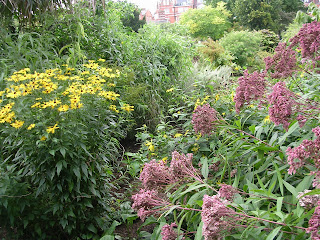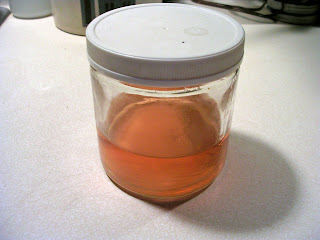Going to use the same photo from the other day. Sorry! It may take me until tomorrow to find another shot of an aloe vera. Anonymous asks:
"Thank you for your comments...I have a question about the aloe vera plant...the leaves keep getting bigger and I am not sure how to harvest them...in order to do as little damage to the plant as possible."
First of all, Anonymous, thanks for the great question. Second of all, my herbal expertise is not medicinal, but I do have a lot of books on herbal medicine. I just have not moved into that stage of my life. I have come up with some answers for you.
Just some general information on Aloe (
Aloe vera) which is a native to tropical and semi-tropical regions of Africa and the Mediterranean. It needs good friable soil and a pot with good drainage if you are growing it in the north. You can sink a pot of aloe if you grow it in the north and use it as an accent in the herb garden.
It is perfect on the windowsill of your kitchen as well. It is best to water it well and then let it dry out almost completely before watering again. It leads to that benign neglect I was talking about. Teetering on the edge of death before being watered! Fertilizing will help it grow well. Repot and divide annually to keep it a manageable size! (That doesn't happen in this house!) It is easily propagated by removing and planting the offshoots that form at the bottom of the parent plant. If you live in the deep south and have a mild winter, aloe will grow outside.
The first is a link from
The National Center for Complementary and Alternative Medicine which is part of the National Institutes of Health which will give you some other links and basic information about aloe vera.
A book I do refer to from time to time is James A. Duke, Ph.D.,
The Green Pharmacy, Emmaus: Rodale Press, 1997. In it he talks about aloe being used to treat burns and other wounds since ancient times.
I quote from his book on Page 104 "Scientists are still not certain how aloe speeds the healing of burns, but the herb appears to have several beneficial effects. One study showed that aloe increases the amount of blood flowing to areas of burned tissue, which brings more of the body's healing resources to the area where they're needed....It is my first-choice herb for burns. Unfortunately, the Food and Drug Administration (FDA) does not share my opinion. Two FDA advisory panels found "insufficient evidence" that aloe is useful for burns. When the FDA says "insufficient evidence," it doesn't mean that the evidence isn't out there--it clearly is, and lots of it. It means only that years ago, when the panels were considering over-the-counter drugs (and when U.S. herbalism was at a low ebb), no one sent the panels enough studies to convince them. And why should they? The herbal believers are already convinced, and there's no economic incentive for drug companies to get aloe approved when anyone can grow it and the companies can't make any money on it."
This one of my favorite contemporary herbal authors these days, Jekka McVicar and this is a reprint of her
New Book of Herbs. It's called
Grow Herbs, London: Dorling Kindersley, Limited, 2010. In it she says: "
HARVESTING Cut fresh leaves throughout the growing season and store in an airtight container in the refrigerator. Plants over two years old have stronger medicinal properties. She also has a
CAUTION The leaves are a potent laxative, and should not be taken by pregnant women or young children." If you are planning to take them internally, please contact a clinical herbalist like Susanna Reppert-Brill or her husband, David Brill at
The Rosemary House. They are located in central Pennsylvania, but may be you can e-mail them for additional information.
Hopefully, Anonymous this has given you some good information. If I have missed something or can answer any other questions about aloe, please let me know.




















































